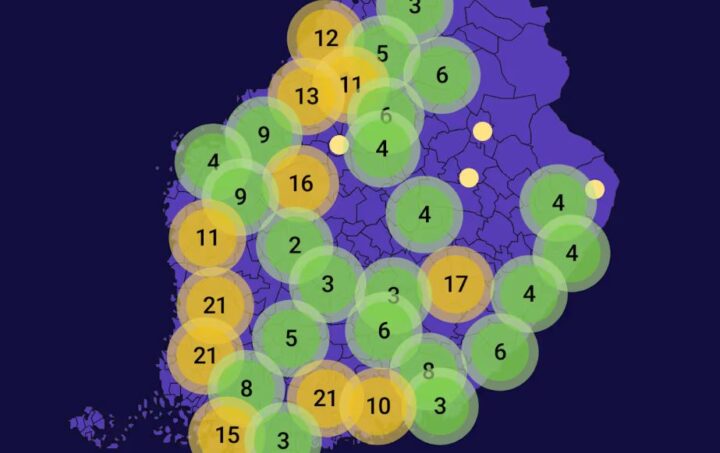Renewable energy from former peat extraction sites: Solar parks
As you can see from the headline photo borrowed from the YLE article, solar energy production is set to expand rapidly in the coming years, and former peat extraction sites present a unique opportunity to accelerate solar development while addressing the environmental consequences of peat extraction. The European Commission’s initiative to identify “renewable go-to areas” designates degraded lands unsuitable for agriculture as priority areas in order to minimize environmental impact. Similarly, the Finnish government’s program aims to steer solar power development toward built environments and former peat production areas, reducing pressure on forests and farmland. However, obtaining permits and navigating the volatility of the energy market have slowed this progress.
Former peat extraction sites are ideal for large-scale solar park development due to their vast, open, and largely barren landscape, with existing infrastructure such as access roads, minimizing the need for land clearance.
Repurposing these sites offers an environmentally responsible alternative to developing solar farms on undisturbed land, reducing unnecessary habitat destruction. Also, unlike wind or hydropower, solar farms are less constrained by specific geographical conditions, allowing for quick installation on land with different characteristics. This ease of implementation and their scalability, make solar energy projects an attractive afteruse for rural landowners. Additionally, solar parks, in contrast to agriculture or forestry alternatives, do not require tilling or fertilization, meaning they do not contribute to the mineralization of peat soils—a primary driver of greenhouse gas (GHG) emissions. This offers a significant environmental advantage by helping to preserve existing carbon stocks.
However, careful attention must be given to peat thickness and moisture levels, as these factors play a critical role in maintaining carbon storage and might vary across the field, making
uniform management difficult. Moreover, the construction of solar parks on peatlands presents specific challenges, including the risk of soil compaction caused by heavy machinery and the continued drainage of peat soils to facilitate installation and maintenance of the solar panels.
Maintaining water levels close to the peat surface is essential for preventing the prolonged exposure of peat to air, its decomposition and the subsequent increased CO₂ emissions. Therefore, strategic rewetting efforts can further enhance carbon sequestration, stabilize site hydrology, and support the long-term restoration of peatland ecosystems. An additional benefit of maintaining higher water levels is the suppression of tall vegetation, reducing the need for frequent mowing and associated disturbances. Properly managed solar parks can thus contribute to improved land conditions, ensuring minimal environmental harm and preserving the site’s suitability for future
uses once the solar park reaches the end of its operational life.
According to a recent publication by the Finnish Peatland Society, 200 solar projects are planned or under construction in Finland, primarily in the south and west. A key example is EPV Energia’s industrial-scale solar park in Lapuan Heinineva. The Heinineva solar power plant, to be completed in late 2025, will be one of the largest in Finland and the first ever to be built on a former peat production area. Covering 120 hectares, it will have an estimated capacity of more than 80 gigawatt-hours of electricity per year. To mitigate environmental risks, the plan is to maintain groundwater levels 30 cm below the surface to prevent the oxidation of acid sulfate soils, as well as a 15 cm layer of clay-rich peat to further minimize emissions. While no vegetation will be planted to reduce maintenance costs, the solar panel layout is planned to allow for potential mowing if
natural plant growth occurs.
Solar parks can also be integrated with other sustainable land uses, such as paludiculture or agrivoltaic farming—where crops are grown beneath solar panels for purposes such as biomass production, animal husbandry, or the creation of pollinator habitats. These dual-use practices could enhance biodiversity and maintain land productivity, offering multifunctional solutions for former peatlands. However, implementing such systems is complex, requiring careful planning, innovative design, and further research to gather data on their long-term feasibility and impacts on rural livelihoods.
Without experimental details, there remains a significant knowledge gap regarding the direct and indirect environmental effects of solar energy developments. This is due to the wide variation in project size, energy capacity, panel and array design, maintenance practices, and site characteristics. Solar installations can influence local microclimates, at the same time altering biogeochemical processes. For instance, research on floating solar photovoltaics has shown to cause changes in wind speed and solar radiation, which in turn impacts the lake’s thermal structure, nutrient cycling, water evaporation rates, and soil conditions. Most existing studies on the environmental impacts of solar energy are based on literature reviews and observations from initial construction phases, while long-term monitoring remains largely absent. Given this lack of data, more pilot projects are needed to assess ecological outcomes comprehensively. The long-term effects of solar
energy developments on peatlands are still poorly understood. As a relatively new industry, the cumulative impacts of solar parks have yet to be measured. Until more evidence is available, applying the precautionary principle in solar park development is essential to mitigate unforeseen environmental risks.
In addition, research specifically addressing the social and cultural impacts of establishing solar panel parks on former peat extraction areas remains limited. Nonetheless, incorporating these dimensions into planning and decision-making processes is crucial for ensuring socially sustainable and locally accepted transitions from peat extraction to renewable energy production. Public perceptions of solar farms—shaped by factors such as aesthetics, economic impacts, and land use changes—play a critical role in determining their acceptance. These projects demand a cultural shift, emphasizing the importance of engaging local communities, understanding their concerns, and fostering transparent communication. Incorporating research on environmental and social impacts into local policies can help cultivate positive attitudes and guide the strategic placement of solar parks.
As long-term ventures, solar energy projects must prioritize equity and justice by considering who benefits and how power dynamics might evolve over time.
Conclusion
The establishment of solar energy parks on former peat extraction sites can offer an environmentally favorable alternative to other land uses, especially in terms of carbon management and soil conservation. With proper planning and responsible water management, solar energy production on former peat extraction sites can play a key role in the green transition, balancing renewable energy production with the conservation of sensitive peatland ecosystems. Also, by integrating multifunctional solutions and engaging communities in meaningful ways, these initiatives can not only generate renewable energy but also support a just and culturally sensitive
transition for regions previously governed by peat extraction.
Key references:
BRE (2014). Biodiversity Guidance for Solar Developments. Eds G E Parker and L Greene. Available at:
https://files.bregroup.com/bre-co-uk-file-library-copy/filelibrary/pdf/Brochures/NSC-Biodiversity-
Guidance.pdf
Bresnihan, P. and Brodie, P. (2023). Data sinks, carbon services: Waste, storage and energy cultures on Ireland’s peat bogs. New Media & Society, 25(2), pp. 361.383
Buechler, S., Spangler, K. and McPhillips, L. (2024). Growing Impact: Community-powered solar farming.
PennState Institute of Energy and the Environment [online] Available at:
https://iee.psu.edu/news/podcast/growing-impact-community-powered-solar-farming
European Commission (2022). Acceleration areas for renewables [online]. Available at: https://joint-researchcentre.
ec.europa.eu/scientific-tools-databases/energy-and-industry-geography-lab-eigl/acceleration-areasrenewables_en
Exley, G., Armstrong, A., Page, T., and Jones, I. D. (2021). Floating photovoltaics could mitigate climate change impacts on water body temperature and stratification. Solar Energy, 219(March), pp. 24–33.
Kahal, N. and Duke, D. (2023). The Impact of Solar Development on Wetlands: Literature Review and
Jurisdictional Scan. [online] Available at: https://abnawmp.ca/wpcontent/
uploads/2023/10/Miistakis_Impact_Solar_Wetlands_Review_Final_20230508.pdf
Laasasenaho, K., Lauhanen, R. and Luhtala, M. (2024). Aurinkovoimalat turvetuotannosta vapautuvilla suonpohjilla ovat massiivisia rakennustyömaita – lisätietoja ympäristövaikutuksista ja maankäyttöristiriidoista tarvitaan. Suo 75(1–2), pp. 73–78.
Tanneberger, F., Appulo, L., Ewert, S., Lakner, S., Brolcháin, N.Ó., Peters, J., and Wichtmann, W.
(2021). The power of nature-based solutions: how peatlands can help us to achieve key eu sustainability
objectives. Advanced Sustainable Systems. 5, 2000146.
The Intelligence Lab (2023). The pros and cons of solar farms in agricultural land. [online] Available at:
https://www.knightfrank.com/research/article/2023-10-24-the-pros-and-cons-of-solar-farms-in-agriculturalland
World Economic Forum (2022). Can crops grow better under solar panels? Here’s all you need to know about ‘agrivoltaic farming’ [online] Available at: https://www.weforum.org/agenda/2022/07/agrivoltaic-farmingsolar-
energy/

